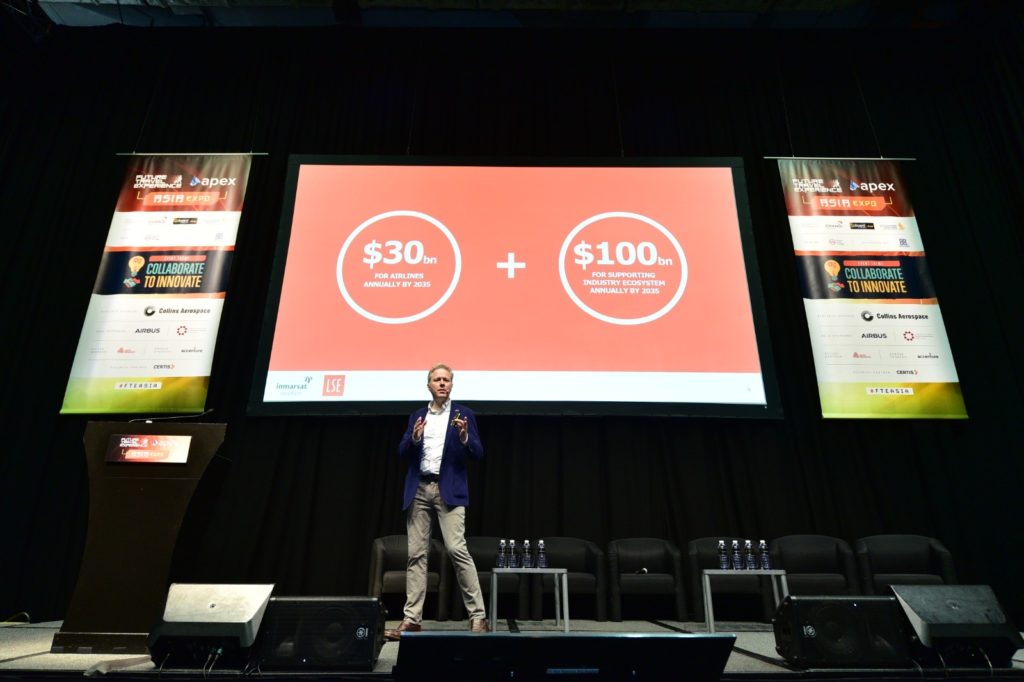Gen Z’s Online Shopping Habits Expected to Translate on Board, Says Inmarsat
Share

Dominic Walters, vice-president of Marketing Communications and Strategy, Inmarsat Aviation, at FTE APEX ASIA EXPO in Singapore. Image: Kok Wee Lim
A study of Generation Z’s travel spending habits exposes a larger trend in how nearly all airline passengers have trained themselves to shop in flight.
Twenty-six dollars doesn’t sound like a lot of money – until you multiply it by 1.2 billion.
New research from the London School of Economics and Political Science (LSE), commissioned by Inmarsat Aviation, suggests that by 2028, Generation-Z passengers will spend an average of $26 on travel purchases during a flight. According to this study, an extension of the third part in LSE’s Sky-High Economics report, which was presented at FTE APEX ASIA EXPO last week, Gen Z is also poised to become the largest group of airline passengers globally within the next decade, with 1.2 billion flying each year by 2028.
Among the main motivations for in-flight travel purchasing identified in LSE’s research included less pre-travel stress and time-wasting, as well as less time spent making reservations upon arrival. “Developing a connected infrastructure built for in-flight spending will be a win-win for both airlines and passengers, bringing airlines the chance to take a slice of revenue currently spent elsewhere in the customer journey, and saving passengers valuable time before and after their flight,” said Dominic Walters, vice-president, Marketing Communications and Strategy at Inmarsat Aviation.
Dr. Alexander Grous, from LSE’s Department of Media and Communications and author of the research, said: “Having grown up in a digital world with connectivity at their fingertips, more often than not Gen Z make last-minute decisions when it comes to travel planning and preparation. This behavioral shift presents an exciting opportunity for airlines to strike innovative partnerships with global and local retailers that extend the possibilities of in-flight spending.”
“Developing a connected infrastructure built for in-flight spending will be a win-win for both airlines and passengers.” – Dominic Walters, Inmarsat Aviation
The study notes that this shift is triggered by a desire to stay constantly connected, as digital technology insinuates itself deeper into our everyday interactions; with social media as the major catalyst for the uptick in time spent online. The redirection of in-flight shopping habits toward digital is not limited to Generation Z: by 2028, millennials are predicted to spend an average of $20 per passenger on in-flight holiday purchases, followed by an average of $19 from baby boomers and Gen-X passengers.
The connected aircraft will soon be table stakes, then, it would seem. “If passengers reject traditional purchase channels in favor of in-flight spending to the extent that this suggests in the next decade, the implications for airlines and retailers would be huge,” said Philip Balaam, president of Inmarsat Aviation. “We may be on the verge of a habitual shift in travel spending, much like the movement from offline to online purchasing witnessed on the ground in the last decade.”
This shift has massive implications for how airlines manage their retail strategies and supply chains, as well as how they market ancillary offers. Not only will airlines need robust and continuous connectivity and product availability, but they will need to communicate these features to their passengers. “With airlines all over the world already ramping up their connectivity offerings and a growing trend for last-minute spending in younger passenger groups,” said Walters, “this is a revolution waiting to happen.”


